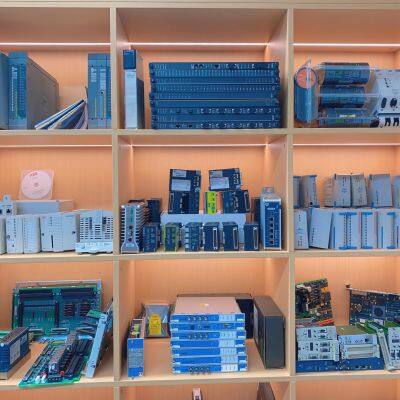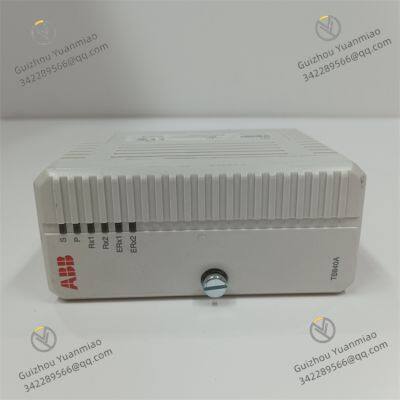Product Description
I. Product Overview
ABB TB840A 3BSE037760R1 is a key communication connection product under ABB, playing a pivotal role in the field of industrial automation. It mainly functions as a Modulebus Cluster Modem. It is an important part of the highly flexible and modular S800 I/O process I/O system. Relying on industry-standard fieldbus technology, this system realizes efficient communication with upper-level controllers and programmable logic controllers (PLCs), providing almost infinitely possible installation and communication solutions for various application scenarios.
The TB840A has a compact size, approximately 5.3 cm x 10.5 cm x 12 cm (data from different sources varies slightly, but the overall specification remains compact), and a relatively light weight of about 4.35 kg. This shape design allows it to be easily installed in industrial control cabinets or inside equipment with limited space without occupying too much valuable space. At the same time, it is convenient for transportation and handling, reducing logistics costs and installation difficulties. Its shell is made of strong and durable materials, with good protective performance, which can effectively resist the erosion of common dust, slight collisions and some corrosive substances in industrial environments, providing reliable protection for internal precision electronic components and ensuring long-term stable operation even under harsh working conditions.

II. Performance Characteristics
(1) Communication Interface Features
Advantages of optical fiber interface: Equipped with 2 optical fiber ports connected to the optical module bus, this design greatly improves the rate and stability of data transmission. In industrial automation scenarios, a large amount of real-time data needs to be transmitted quickly and accurately. Optical fiber communication, with its characteristics such as high rate (which can easily meet the needs of industrial large data transmission, such as the rapid upload and download of equipment status data and process parameters in high-speed production lines), strong anti-interference ability (which can effectively avoid the impact of electromagnetic interference on signal transmission, ensuring the accuracy of data transmission and reducing bit error rate in industrial environments with a large number of strong electromagnetic interference sources such as motors and frequency converters), and small signal attenuation during long-distance transmission (suitable for connecting equipment in different areas of large factories without frequent relays, ensuring the reliability of communication links), has become an ideal choice for industrial communication. The optical fiber interface of TB840A lays a solid foundation for building an efficient and stable industrial communication network.
Function of electrical interface: It has a module bus (electrical) interface connected to I/O modules, which logically belongs to different branches of the same bus system as the optical fiber interface. Through this electrical interface, TB840A can be conveniently connected to various I/O modules to realize signal aggregation and distribution. In practical applications, it can connect up to 12 I/O modules to the electrical module bus, which means that in a local area, it can centrally manage and coordinate the work of multiple I/O devices. For example, in a workstation of an automated production line, I/O modules responsible for different functions (such as detection, control, execution, etc.) can be uniformly connected to the electrical interface of TB840A to realize centralized control and data collection of the equipment in this workstation.
(2) Redundant Design
TB840A is mainly used in redundant configuration scenarios. In such configurations, each module is connected to different optical module bus lines but to the same electrical module bus. This redundant design greatly enhances the reliability and fault tolerance of the system. When a fault occurs in one optical module bus line (such as communication interruption due to physical damage, signal interference, etc.), the module can automatically switch to another normal optical module bus line for data transmission, ensuring that the communication of the entire system is not interrupted and the production process is not affected. Taking the petroleum and chemical industry as an example, in the monitoring system of crude oil transmission pipelines, a large number of sensors and actuators are connected to TB840A through I/O modules. If one of the optical module bus lines fails in complex underground environments or harsh weather conditions, the redundantly configured TB840A can ensure the continuous upload of monitoring data and the issuance of control commands, avoiding production accidents caused by communication failures.
(3) Monitoring and Power Supply Functions
Monitoring function: It has the function of monitoring the I/O module bus and power supply. It can real-time monitor the communication status of the connected I/O module bus, including key indicators such as data transmission rate, bit error rate, and connection stability. Once an abnormality is found, it can issue an alarm in time to remind maintenance personnel to check and repair. At the same time, it also monitors the power supply status in real-time, such as whether the power supply voltage is within the normal range and whether the current is overloaded. This comprehensive monitoring capability helps to detect potential problems in advance, prevent faults, and ensure the stable operation of the entire industrial automation system. In the substation automation system of the power industry, the monitoring function of TB840A on the I/O module bus and power supply can ensure the reliability of status monitoring and control command execution of many switchgear, protection devices, etc., avoiding abnormal operation of the substation due to communication or power supply problems.
Power supply characteristics: It provides isolated power supply for I/O modules, which effectively prevents the impact of power supply interference on the normal operation of I/O modules. In industrial environments, problems such as power supply fluctuations and electromagnetic interference are common. Isolated power supply can provide a stable and pure power supply environment for I/O modules, ensuring that they can accurately collect and transmit signals. For example, in the high-temperature and strong electromagnetic interference production workshops of the metallurgical industry, the isolated power supply of TB840A can provide stable power supply for connected I/O modules such as temperature sensors and pressure sensors, ensuring the accuracy of sensor data collection, and thus providing a reliable basis for precise control of the production process.

III. Application Scenarios
(1) Automated Production Lines in Manufacturing Industry
In the automated production lines of manufacturing industries such as automobile manufacturing and electronic equipment manufacturing, TB840A plays a crucial role as a communication hub. The production line is composed of a large number of automated equipment, such as robots, conveyor belts, detection equipment, etc., and these equipment are connected to TB840A through various I/O modules. For example, in an automobile welding production line, the issuance of action commands and feedback of working status of welding robots, the start-stop control of conveyor belts and the transmission of position detection signals all depend on the communication network built by TB840A. Its redundant design ensures that even if a communication line fails during the long-term and high-intensity operation of the production line, the production line will not stop, ensuring the continuity and efficiency of production, and improving product quality and production efficiency.
(2) Petroleum and Chemical Industry
The petroleum and chemical production process is complex, involving a large number of pumps, valves, compressors and other equipment, as well as various sensors for monitoring parameters such as pressure, temperature, and flow. TB840A can be connected to the I/O modules of these equipment to realize real-time monitoring and remote control of equipment status. In large refineries, links such as crude oil transmission, refining, and product storage and transportation require precise automated control. Through its high-speed and stable communication interface, TB840A quickly transmits equipment status data distributed in different areas to the central control system, and at the same time accurately issues control commands to various executive equipment. Its monitoring function for I/O module bus and power supply, as well as redundant design, ensures the reliability of the communication system in harsh environments such as high temperature, high pressure, flammability and explosion, guarantees production safety, and prevents production accidents caused by communication failures.
IV. Installation Steps
Preparation before installation: Before installing TB840A, it is necessary to carefully check whether the surface of the equipment has obvious damage, deformation, rust, etc., to ensure that the appearance of the equipment is intact. At the same time, carefully check whether the model and quantity of the equipment and its accessories are consistent according to the packing list, to avoid affecting the installation progress due to missing accessories or wrong models. In addition, it is also necessary to confirm whether the technical parameters of the equipment (such as communication interface specifications, power supply requirements, etc.) meet the design requirements, to ensure that the equipment can be perfectly compatible with the existing system. The installation environment also needs to meet the equipment requirements, such as temperature, humidity, electromagnetic interference and other environmental factors should be within the scope specified by the equipment to ensure the normal operation of the equipment.
Electrical connection: Carry out electrical connection strictly in accordance with the electrical drawings to ensure that the wiring is correct and firm. During the connection process, attention should be paid to distinguishing the functions of different interfaces to avoid equipment damage or communication failures caused by wrong wiring. For the optical fiber interface, careful operation is required during connection to avoid excessive bending or contamination of the optical fiber, which may affect the quality of optical signal transmission. After the connection is completed, all wiring should be checked again for firmness to prevent loosening during the operation of the equipment.
Equipment installation and fixing: Install the equipment in accordance with the equipment layout drawing and installation instructions, accurately install TB840A in the predetermined position, and ensure that the equipment is installed firmly. During the installation process, care should be taken to avoid collision or vibration to the equipment to prevent damage to internal components. For equipment that needs to be installed in the cabinet, the installation position should be reasonably planned to ensure good ventilation and facilitate subsequent maintenance and overhaul.


BENTLY 190782-01 Communication Gateway Module
Bently 145988-01 VGA Display Module
Bently 323174-01 Emergency Shutdown Device
Bently 147663-01 VGA Display I/O Module
GE VMIVME-2540 Counter/Controller
GE F650BFBF2G0HIE Feeder Protection Relay
ABB PM865 3BSE030193R1 Programmable Controller
GE SLN080 IC086SLN080-A PACSystems Industrial Ethernet Switches
GE SLN042 IC086SLN042-A PACSystems Industrial Ethernet Switches
EMERSON 5X00106G02 Analog Input Module
EMERSON 5X00419G02 Controller Module
EMERSON 5X00875G01 Controller Atom CPU Module
EMERSON 1C31113G01 Analog Input Module
EMERSON 5X00453G01 Power Supply Module
ABB PPD513A-23-111615 magnetic excitation controller
TRICONEX Safety Instrumented System (SIS) 4351B control module
Bentley Nevada 3500/22M Transient data interface module
Bently Nevada 3500/15-05-05-00 power module
Triconex 3009 processor module
ABB GFD563A102 3BHE046836R0102 Excitation Convection Interface Module
ABB PPD117A3011 3BHE030410R3011 Excitation Controller
ABB PCD231B101 3BHE025541R0101 Excitation Unit Controller
ABB 5SHY3545L0010 3BHE009681R0101 High-Voltage Thyristor Module
ABB PCD230A 3BHE022291R0101 Controller Module
 yezi
Hi there! Welcome to my shop. Let me know if you have any questions.
yezi
Hi there! Welcome to my shop. Let me know if you have any questions.




